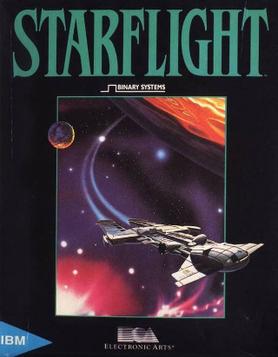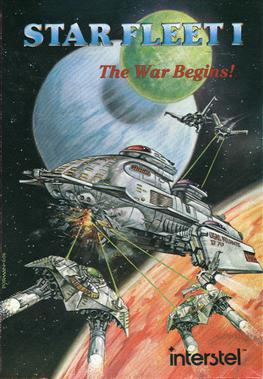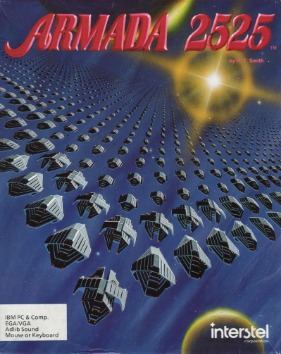Quantum Quality Productions was a computer games company specializing in strategy games and war games.

Starflight is a space exploration, combat, and trading role-playing video game created by Binary Systems and published by Electronic Arts in 1986. Originally developed for IBM PC compatibles, it was later ported to the Amiga, Atari ST, Macintosh, and Commodore 64. A fully revamped version of the game was released for the Sega Genesis in 1991.

Star Trek is a text-based strategy video game based on the Star Trek television series (1966–69) and originally released in 1971. In the game, the player commands the USS Enterprise on a mission to hunt down and destroy an invading fleet of Klingon warships. The player travels through the 64 quadrants of the galaxy to attack enemy ships with phasers and photon torpedoes in turn-based battles and refuel at starbases. The goal is to eliminate all enemies within a random time limit.

Galactic Civilizations II: Dread Lords is a 4X turn-based strategy by Stardock for Microsoft Windows. It is the sequel to the 2003 game, Galactic Civilizations, and was released at retail and on Stardock's online subscription service, TotalGaming.net, on February 21, 2006. An expansion, Dark Avatar, was released in February 2007. A second expansion, Twilight of the Arnor, was released in April 2008.

Master of Orion II: Battle at Antares is a 4X turn-based strategy game set in space, designed by Steve Barcia and Ken Burd, and developed by Simtex, who developed its predecessor Master of Orion and Master of Magic. The PC version was published by MicroProse in 1996, and the Macintosh version a year later by MacSoft, in partnership with MicroProse. The game has retained a large fan base, and is still played online.

Wing Commander II: Vengeance of the Kilrathi is the first sequel in Chris Roberts' Wing Commander science fiction space combat simulator franchise of computer games, produced by Origin Systems.

Star Trek: Strategic Operations Simulator is a space combat simulation arcade video game based on the original Star Trek television program and movie series, and released by Sega in 1983. Star Trek uses color vector graphics for both a 2D display and a 3D first-person perspective. The player controls the Starship Enterprise and must defend sectors from invading Klingon ships. The game includes synthesized speech
Rebel Space was the second play-by-email game offered as part of a major commercial online service. It ran on Prodigy from 1992 to 1995. The game was developed by Stormfront Studios, designed by Don Daglow and programmed by Mark Buchignani.

Strike Fleet is a 1988 video game developed by Lucasfilm Games and published by Electronic Arts. It was released for the Amiga, Apple II, Atari ST, Commodore 64, and MS-DOS. Strike Fleet is the unofficial sequel to the war game PHM: Pegasus.
The Star Fleet computer games are starship tactical combat simulations originally created by Dr. Trevor Sorensen in the late 1970s.

Empire is a 1977 turn-based wargame with simple rules. The game was conceived by Walter Bright starting in 1971, based on various war movies and board games, notably Battle of Britain and Risk. The game was ported to many platforms in the 1970s and 1980s. Several commercial versions were also released, often adding basic graphics to the originally text-based user interface. The basic gameplay is strongly reminiscent of several later games, notably Civilization, which was partly inspired by Empire.

Empire! is a space combat and trading video game designed by Andrew Glaister and published by Firebird Software in 1986 for the Commodore 64, ZX Spectrum, and Amstrad CPC.

Starfleet I: The War Begins is a 1984 strategy computer game designed by Trevor Sorensen and developed by Interstel. It was released for Apple II, DOS and Commodore 64. Versions for the Commodore 128, Atari ST and Atari 8-bit family were released in 1986 and versions for the Amiga and Macintosh were released in 1987. The game was successful enough to spawn sequels which are collectively known as the Star Fleet series.
A space flight simulation is a genre of flight simulator video games that lets players experience space flight to varying degrees of realism. Common mechanics include space exploration, space trade and space combat.

Empire: Wargame of the Century is a video game based on Empire developed by Walter Bright and published by Interstel Corporation in 1987.

Star Fleet II: Krellan Commander is a video game and the sequel to Star Fleet I: The War Begins.
Solving chess consists of finding an optimal strategy for the game of chess; that is, one by which one of the players can always force a victory, or either can force a draw. It is also related to more generally solving chess-like games such as Capablanca chess and infinite chess. In a weaker sense, solving chess may refer to proving which one of the three possible outcomes is the result of two perfect players, without necessarily revealing the optimal strategy itself.

Armada 2525 is a 4X science fiction computer strategy game developed by Robert T. Smith and published by Interstel Corporation. It was released in North America in 1991 for $49.95. An updated version called Armada 2525 Deluxe was also released the following year which featured updated gameplay, graphics and improved multiplayer.

Starbase Hyperion is a 1980 video game written by Don Ursem for the Exidy Sorcerer and published by Quality Software in 1980. An Atari 8-bit family port followed in 1981.













